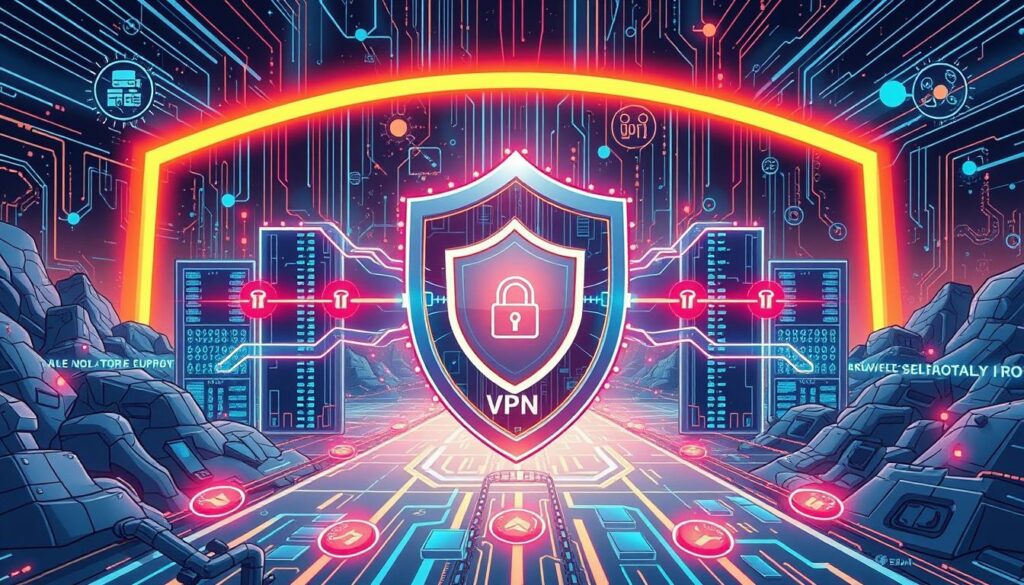Did you know over 90% of organizations worldwide face cyberattacks? Yet, less than half are ready to fight back? IT firewalls and VPNs are key to protecting networks. They work together to keep data safe and private, making networks more secure.
This section will explore how these technologies protect against cyber threats. We’ll see how their teamwork creates a strong defense against attacks.
Key Takeaways
- Addition of IT firewalls and VPNs can create a layered defense against threats.
- VPNs provide secure, encrypted channels for data transmission.
- A proactive approach utilizing both tools can safeguard against evolving cyber threats.
- Combining these solutions improves overall network performance and security.
- Understanding the functionalities of firewalls and VPNs is crucial for effective security management.
Understanding Firewalls in Network Security
In today’s digital world, IT Firewalls are key to keeping networks safe. They watch over incoming and outgoing traffic, following set security rules. This is crucial for keeping data safe and fighting off threats.
Definition and Purpose of IT Firewalls
IT Firewalls are a strong defense for networks. They block unwanted access and lower cyber risks. These systems let only safe traffic through, protecting important info from hackers.
Types of Firewalls
Knowing about different firewalls is key to better network security. The main types are:
- Hardware Firewalls: These are physical devices that guard your network from threats.
- Software Firewalls: These are on devices and can be set up to fit specific needs, fighting local threats.
- Cloud-Based Firewalls: These are in the cloud and offer flexibility and growth for companies moving to new environments.
How Firewalls Protect Organizational Networks
IT Firewalls must keep up with new cyber threats. Here are some stats that show why:
- There was a 53% jump in new malware types found from April to June 2024, showing the need for strong firewalls.
- BlackBerry blocked an average of 11,500 new malware samples every day during that period.
- They stopped about 3.7 million cyberattacks, with 43,500 daily, showing how crucial firewalls are.
Firewalls are vital for stopping unauthorized access and keeping key sectors safe. As threats grow, knowing about firewalls and using them well is key to better security.
| Type of Firewall | Advantages | Best Use Cases |
|---|---|---|
| Hardware Firewalls | Robust protection, physical device | Perimeter security |
| Software Firewalls | Customizable, device-specific | Individual device security |
| Cloud-Based Firewalls | Scalable and flexible | Hybrid network environments |
The Role of VPNs in Network Security
A Virtual Private Network (VPN) is key to keeping your internet connection safe. With more people working from home, knowing how VPNs help is crucial. They encrypt your data and keep your online activities private, stopping hackers and unauthorized access.
What is a VPN?
A VPN creates a secure tunnel over the internet. It lets you connect to a private network from anywhere. It hides your IP address and encrypts your data, keeping it safe as it goes online. This is especially important for remote work or accessing sensitive info on public networks.
Benefits of Using VPNs for Secure Remote Access
- Data Encryption: VPNs encrypt your data, making it unreadable to interceptors and hackers.
- Anonymity: Users can browse the internet anonymously, ensuring that their online activities remain private.
- Access Control: VPNs allow secure access to company resources and sensitive data even from remote locations.
- Bypass Geo-Restrictions: Users can easily access content and services that may be restricted in their geographical location.
Types of VPNs: Which Is Right for You?
Knowing the different VPN types helps you pick the best one. Here are a few common ones:
| Type of VPN | Description | Ideal Use Case |
|---|---|---|
| Remote Access VPN | Connects individual users to a remote server securely. | Best for employees working from home or on the go. |
| Site-to-Site VPN | Connects entire networks or multiple offices securely. | Ideal for businesses with multiple locations needing a secure connection between sites. |
| Mobile VPN | Designed for mobile devices, maintaining connections during varying network conditions. | Perfect for users who frequently switch networks, such as traveling professionals. |
The Importance of a Secure Network Architecture
In today’s digital world, a secure network is key. With the rise of remote work and cloud use, threats have grown. It’s vital to know the new risks these changes bring.
Challenges of Today’s Evolving Threat Landscape
Remote work has made it easier for hackers to attack. A PwC survey shows cloud attacks are now the biggest worry for business leaders. The FBI reports that email scams cost businesses $2.9 billion in 2023.
AI threats are also on the rise. Companies must be ready for more complex attacks.
How Remote Work and Cloud Adoption Affect Security
Cloud use is set to grow, with over 70% of businesses using it by 2027. Cloud tech boosts work efficiency but also brings new risks. It’s important to protect data and keep operations safe.
Consider using advanced security tools and zero trust strategies. This ensures your network is secure.
For more on how to keep your data safe, check out quantum cryptography. It’s a cutting-edge way to secure your communications. Staying ahead of threats is essential for your digital success.
Perimeter-Based Security vs. Modern Security Approaches
The security world has changed a lot in recent years. Old ways of protecting data are no longer enough. Perimeter-based security tries to keep data safe by focusing on the outer layer of a network. But, as networks grow, this method has big limitations.
The Limitations of Perimeter-Based Security
Companies using old security methods face new threats. With more people working from home and using cloud services, the attack area gets bigger. This makes it hard for old security to stop smart attacks.
Issues like not following rules, unauthorized access, and moving laterally in a network can harm data. Attacks like SQL injections or iFrame injections show why we need better security.
Why Perimeter Security Cannot Keep Up with Current Threats
New security methods are key to fighting today’s dangers. Old defenses can’t handle the pressure from mobile devices, remote work, and cloud services. Zscaler is a new solution that uses AI and zero trust to change how we protect data.
It handles over 400 billion transactions every day, catching 500 trillion signals. This helps companies stay ahead of security issues and work better.
It’s important to update security plans with new ideas. Using zero trust and advanced tech gives a strong defense against changing threats. For more on modern security and remote work, check out this resource.
IT Firewalls: Strengths and Weaknesses
IT Firewalls are key in keeping networks safe from unauthorized access and cyber threats. Knowing their strengths and weaknesses helps organizations protect their networks better. This way, they can avoid and deal with risks more effectively.
Strengths of IT Firewalls in Network Protection
IT Firewalls have many benefits for network security, including:
- Traffic Monitoring: They watch and manage traffic, stopping harmful activities.
- Access Control: Firewalls block unauthorized access to important data, making sure only approved users can access it.
- Defense Against External Threats: They protect against outside cyber threats, making it harder for hackers to get in.
- Support for Compliance: Firewalls help meet legal requirements by monitoring and controlling data.
Common Weaknesses and Vulnerabilities
Even with their benefits, IT Firewalls have some weaknesses that need attention:
- Inability to Detect Sophisticated Attacks: Advanced threats can sometimes get past firewalls, especially if they get into the network first.
- Vulnerabilities to Exploit: Old or unpatched systems can be weak spots for attackers.
- Challenges with Encrypted Traffic: Firewalls might struggle to check encrypted data, missing some threats.
- Incident Response Delays: Too much data can slow down response to security incidents, making recovery take longer.
How VPNs Complement Firewalls
Using VPNs with firewalls makes your network security stronger. This combo is key in today’s digital world. It helps keep remote users safe and keeps your resources secure.
VPNs help by checking who’s on your network and encrypting their data. This extra layer of security works well with firewalls.
Integrating VPNs for Enhanced Network Security
Adding VPNs to your security plan makes your data safer. Firewalls and VPNs together protect against unauthorized access. They also help with the risks of remote work.
This approach lets you:
- Give secure access to your systems for remote workers.
- Make data safe as it moves between users and your network.
- Make sure only the right people can see your sensitive info.
This strategy is more important than ever. More companies are working flexibly and using the cloud.

Challenges When Relying Solely on Firewalls and VPNs
While VPNs and firewalls are great together, using only them has its downsides. A big issue is feeling too safe when you’re not. Many think they’re fully protected, but they’re not.
The main problems are:
- They don’t catch all threats, leaving your network open to attacks.
- Once in, threats can spread through your network.
- Depend too much on these tools and you might miss other security steps.
To really protect your organization, you need to see the limits of just using firewalls and VPNs. You should keep checking your security and add more layers to stay safe.
Cybersecurity Threats Targeting Firewalls and VPNs
In today’s digital world, your network’s security is always at risk. Cybercriminals are getting smarter, making it key to know about firewalls and VPNs’ weaknesses. These threats can harm your data and systems if not stopped.
Common Threats Exploiting VPN Vulnerabilities
VPN weaknesses can put your organization in danger. Hackers look for mistakes, outdated software, and weak encryption. This opens the door to attacks like:
- Man-in-the-middle attacks – Allowing attackers to intercept and manipulate communications.
- Data interception – Eavesdropping on sensitive data transmitted over insecure connections.
- Credential theft – Exploiting weak passwords or insecure access methods to gain unauthorized entry.
A 278% increase in incidents in critical sectors like healthcare shows the need for strong network protection. Ransomware attacks have caused big problems, leading to losses and data breaches.
Understanding Lateral Movement in Networks
After getting into a network, attackers move laterally, increasing the risk. This lets them access more data and systems. It’s important to watch for unusual activity to catch these moves early.
Using a Zero Trust approach helps verify every user and device. This reduces the damage from breaches. Advanced firewalls and anti-data exfiltration solutions are also key to keeping data safe.
The Role of Zero Trust Architecture in Network Security
Understanding zero trust architecture is key in today’s threat world. It changes how we think about network security. Instead of trusting everyone, it verifies every user and device.
Principles of Zero Trust
The zero trust model has several important parts:
- Never trust, always verify: Every device and user must be authenticated before receiving access.
- Least-privileged access: Users are granted minimal levels of access needed for their roles, reducing potential attack surfaces.
- Continuous monitoring: All traffic is scrutinized continuously to detect anomalies and potential breaches.
- Assume breaches: Organizations operate under the assumption that breaches may have already occurred, preparing them to react effectively.
How Zero Trust Redefines Network Security
Zero trust architecture changes how we secure networks. It boosts defense against unauthorized access and secures sensitive data. With digital transformation, securing diverse environments is crucial. Artificial intelligence helps by automating threat detection and analysis.
The table below shows the difference between zero trust and traditional security:
| Aspect | Traditional Security | Zero Trust Architecture |
|---|---|---|
| Trust Model | Trust based on location/network | Verify every request regardless of location |
| Access Control | Broad access once inside | Least-privileged access |
| Monitoring | Periodic audits | Continuous traffic monitoring |
| Assumptions on Breaches | Assumes network is secure | Assumes breaches can occur |

Implementing a Comprehensive Network Security Strategy
In today’s digital world, having a strong network security strategy is key. It protects sensitive data from potential threats. To improve your security, start by checking your current setup for weaknesses. Look into using modern tools, like zero trust architecture, to boost your defenses.
A multi-layered security approach helps tackle different types of attacks. This way, you can protect your network better.
Steps to Improve Your Current Security Architecture
To strengthen your security, set up specific firewall rules. These rules should allow access to important resources, like NAS systems for ISO storage and backups. Using aliases makes it easier to manage devices, especially those with changing IP addresses.
It’s also wise to use specific ports for services like Samba. Control access with rules for MAC addresses, IP addresses, and FQDNs. This setup ensures safe communication between virtual servers and Wi-Fi devices. It also reduces your attack surface with VLAN subnetting.
The Importance of Continuous Monitoring and Update
Keeping your network secure means constant monitoring and updates. As threats change, being proactive helps you stay ahead. Regular training and awareness programs for your team are crucial.
They help employees spot and handle security threats. By focusing on these steps, you create a strong, secure network. You also build a culture that values security within your organization.
FAQ
What are the main functions of firewalls in network security?
Firewalls protect networks by blocking unauthorized access. They control incoming and outgoing traffic. This ensures only approved data passes through.
How do VPNs enhance network security?
VPNs create a secure internet connection. They encrypt data and keep users anonymous. This makes remote access safe and secure.
What types of firewalls are available for organizations?
Organizations can choose from hardware, software, and cloud-based firewalls. Each type meets different security needs.
Why is zero trust architecture important for network security?
Zero trust architecture verifies all access requests. It assumes threats can exist anywhere. This approach provides strong defense against cyber threats.
What are common cybersecurity threats that affect firewalls and VPNs?
Cyber threats include misconfigurations and outdated software. These can lead to attacks like man-in-the-middle and data interception.
How does remote work impact network security?
Remote work increases the attack surface. It relies on remote access and third-party vendors. This requires stronger security measures.
What are the limitations of perimeter-based security?
Perimeter security is not enough against advanced threats. It’s designed to protect the network’s edge but fails against lateral threats. With remote work and cloud apps, it’s no longer effective.
How can organizations improve their network security posture?
Organizations should evaluate their security and adopt a zero trust strategy. Regular monitoring, updates, and employee training are also key.
Source Links
1 .TUF Gaming BE6500 | ASUS North Africa
2 . BlackBerry report: Cyber threats up 53%, critical sectors hit
3 . “Hacking” an Election is Harder Than You Think – But Security is Still a Priority
- My Guide to Understanding Data Centre Architecture: Core Components Every IT Pro Should Know
- Wazuh Home Network Setup: A Step-by-Step Guide
- Quantum Computers Decrypting Blockchain: The Risks and Implications
- Wazuh: Enterprise-Grade Security for Your Business
- Wazuh for Beginners: A Comprehensive Guide
Related posts:
 How to Troubleshoot Common Firewall Issues
How to Troubleshoot Common Firewall Issues
 The Role of Quantum Cryptography in Future Cybersecurity
The Role of Quantum Cryptography in Future Cybersecurity
 How to Set Up a Virtual Firewall for Your Cloud Infrastructur
How to Set Up a Virtual Firewall for Your Cloud Infrastructur
 Firewall Management Tools: How to Choose the Best Solution
Firewall Management Tools: How to Choose the Best Solution
 CISSP Domain 3: Security Architecture and Engineering
CISSP Domain 3: Security Architecture and Engineering
 CISSP Domain 4: Communication and Network Security
CISSP Domain 4: Communication and Network Security
